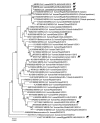Asymptomatic MERS-CoV Infection in Humans Possibly Linked to Infected Dromedaries Imported from Oman to United Arab Emirates, May 2015 - PubMed (original) (raw)
. 2015 Dec;21(12):2197-200.
doi: 10.3201/eid2112.151132.
Daniel K W Chu, Yassir M Eltahir, Farida Al Hosani, Mariam Al Mulla, Wasim Tarnini, Aron J Hall, Ranawaka A P M Perera, Mohamed M Abdelkhalek, J S M Peiris, Salama S Al Muhairi, Leo L M Poon
- PMID: 26584223
- PMCID: PMC4672428
- DOI: 10.3201/eid2112.151132
Asymptomatic MERS-CoV Infection in Humans Possibly Linked to Infected Dromedaries Imported from Oman to United Arab Emirates, May 2015
Zulaikha M Al Hammadi et al. Emerg Infect Dis. 2015 Dec.
Abstract
In May 2015 in United Arab Emirates, asymptomatic Middle East respiratory syndrome coronavirus infection was identified through active case finding in 2 men with exposure to infected dromedaries. Epidemiologic and virologic findings suggested zoonotic transmission. Genetic sequences for viruses from the men and camels were similar to those for viruses recently detected in other countries.
Keywords: MERS; MERS-COV; Middle East respiratory syndrome coronavirus; Oman; United Arab Emirates; asymptomatic infection; camels; coronavirus; dromedaries; epidemiology; humans; transmission; viruses; zoonoses.
Figures
Figure
Phylogenetic analyses of partial Middle East respiratory syndrome coronavirus (MERS-CoV) genomic sequences for viruses detected in dromedaries imported from Oman to United Arab Emirates, May 2015. A partial viral RNA sequence spanning the 3′ end of the open reading frame 1AB gene through the 3′ untranslated region of the MERS-CoV genome (≈8,900 nt) was used in the analysis. The phylogenetic tree was constructed with MEGA6 software (
) by using the neighbor-joining method. Numbers at nodes indicate bootstrap values determined by 1,000 replicates. Only bootstrap values >70 are denoted. Underlining indicates sequences for viruses detected in this study. GenBank accession numbers are shown for published sequences. Symbols indicate MERS-CoVs detected from dromedaries s. Scale bar indicates the estimated genetic distance of these viruses.
Similar articles
- Middle East Respiratory Syndrome Coronavirus Antibodies in Bactrian and Hybrid Camels from Dubai.
Lau SKP, Li KSM, Luk HKH, He Z, Teng JLL, Yuen KY, Wernery U, Woo PCY. Lau SKP, et al. mSphere. 2020 Jan 22;5(1):e00898-19. doi: 10.1128/mSphere.00898-19. mSphere. 2020. PMID: 31969478 Free PMC article. - Limited Genetic Diversity Detected in Middle East Respiratory Syndrome-Related Coronavirus Variants Circulating in Dromedary Camels in Jordan.
Seifert SN, Schulz JE, Ricklefs S, Letko M, Yabba E, Hijazeen ZS, Holloway P, Al-Omari B, Talafha HA, Tibbo M, Adney DR, Guitian J, Amarin N, Richt JA, McDowell C, Steel J, Abu-Basha EA, Al-Majali AM, van Doremalen N, Munster VJ. Seifert SN, et al. Viruses. 2021 Mar 31;13(4):592. doi: 10.3390/v13040592. Viruses. 2021. PMID: 33807288 Free PMC article. - Prevalence of Middle East respiratory syndrome coronavirus (MERS-CoV) in dromedary camels in Abu Dhabi Emirate, United Arab Emirates.
Yusof MF, Eltahir YM, Serhan WS, Hashem FM, Elsayed EA, Marzoug BA, Abdelazim AS, Bensalah OK, Al Muhairi SS. Yusof MF, et al. Virus Genes. 2015 Jun;50(3):509-13. doi: 10.1007/s11262-015-1174-0. Epub 2015 Feb 5. Virus Genes. 2015. PMID: 25653016 Free PMC article. - Middle East respiratory syndrome coronavirus antibody reactors among camels in Dubai, United Arab Emirates, in 2005.
Alexandersen S, Kobinger GP, Soule G, Wernery U. Alexandersen S, et al. Transbound Emerg Dis. 2014 Apr;61(2):105-8. doi: 10.1111/tbed.12212. Epub 2014 Jan 24. Transbound Emerg Dis. 2014. PMID: 24456414 Free PMC article. Review. - Middle East respiratory syndrome (MERS) coronavirus and dromedaries.
Wernery U, Lau SK, Woo PC. Wernery U, et al. Vet J. 2017 Feb;220:75-79. doi: 10.1016/j.tvjl.2016.12.020. Epub 2017 Jan 9. Vet J. 2017. PMID: 28190501 Free PMC article. Review.
Cited by
- Identification of diverse viruses in upper respiratory samples in dromedary camels from United Arab Emirates.
Li Y, Khalafalla AI, Paden CR, Yusof MF, Eltahir YM, Al Hammadi ZM, Tao Y, Queen K, Hosani FA, Gerber SI, Hall AJ, Al Muhairi S, Tong S. Li Y, et al. PLoS One. 2017 Sep 13;12(9):e0184718. doi: 10.1371/journal.pone.0184718. eCollection 2017. PLoS One. 2017. PMID: 28902913 Free PMC article. - Cross-sectional prevalence study of MERS-CoV in local and imported dromedary camels in Saudi Arabia, 2016-2018.
Tolah AM, Al Masaudi SB, El-Kafrawy SA, Mirza AA, Harakeh SM, Hassan AM, Alsaadi MA, Alzahrani AA, Alsaaidi GA, Amor NMS, Alagaili AN, Hashem AM, Azhar EI. Tolah AM, et al. PLoS One. 2020 May 26;15(5):e0232790. doi: 10.1371/journal.pone.0232790. eCollection 2020. PLoS One. 2020. PMID: 32453746 Free PMC article. - Middle East respiratory syndrome.
Memish ZA, Perlman S, Van Kerkhove MD, Zumla A. Memish ZA, et al. Lancet. 2020 Mar 28;395(10229):1063-1077. doi: 10.1016/S0140-6736(19)33221-0. Epub 2020 Mar 4. Lancet. 2020. PMID: 32145185 Free PMC article. Review. - Sputum Processing Method for Lateral Flow Immunochromatographic Assays to Detect Coronaviruses.
Kang A, Yeom M, Kim H, Yoon SW, Jeong DG, Moon HJ, Lyoo KS, Na W, Song D. Kang A, et al. Immune Netw. 2021 Feb 18;21(1):e11. doi: 10.4110/in.2021.21.e11. eCollection 2021 Feb. Immune Netw. 2021. PMID: 33728104 Free PMC article. - A Review of Zoonotic Pathogens of Dromedary Camels.
Zhu S, Zimmerman D, Deem SL. Zhu S, et al. Ecohealth. 2019 Jun;16(2):356-377. doi: 10.1007/s10393-019-01413-7. Epub 2019 May 28. Ecohealth. 2019. PMID: 31140075 Free PMC article. Review.
References
- World Health Organization. Middle East respiratory syndrome coronavirus (MERS-CoV): summary and risk assessment of current situation in the Republic of Korea and China—as of 19 June 2015. [cited 2015 Aug 8]. http://www.who.int/emergencies/mers-cov/mers-cov-republic-of-korea-and-c...
Publication types
MeSH terms
Substances
LinkOut - more resources
Full Text Sources
Other Literature Sources
